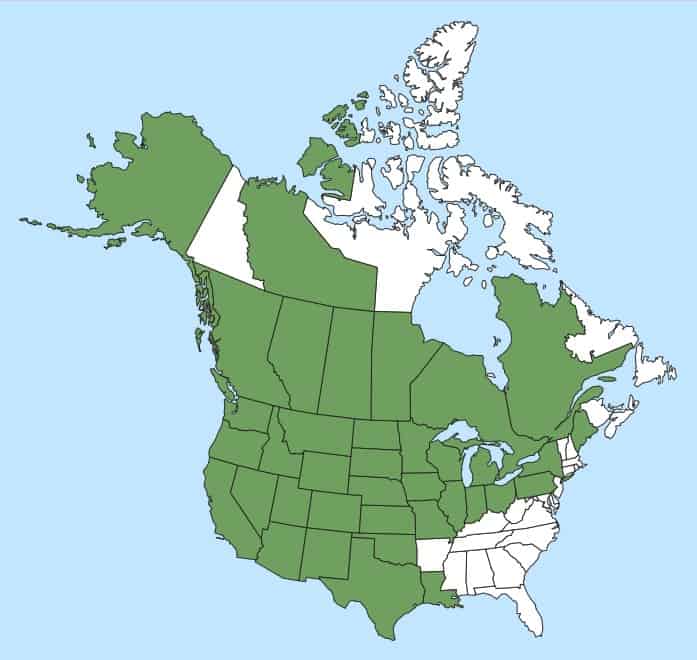Lactuca oblongifolia
Explore More :
Explore plus :
Overview
Aperçu
Regulation :
Remarques Réglementation:
- Quarantine lists of countries e.g. China *may be updated without notice
Regulation Notes:
On quarantine lists of countries e.g. China*.
*Quarantine lists of countries may be updated without notice.
Distribution :
Répartition :
This species is native to North America, where it is common in the western and central United States and Canada and less so in the east (USDA-ARS 2017; USDA-NRCS 2017).
Habitat and Crop Association :
Habitat et Cultures Associées :
Blue lettuce grows in cultivated fields, prairies, meadows, clearings in forests or shrublands, shores, railway lines, roadsides and disturbed areas (Gleason and Cronquist 1991; Darbyshire 2003; FNA 2017). Prefers moist areas (Gleason and Cronquist 1991).
Economic Use, cultivation area, and Weed Association :
Utilisation économique, zone de culture et association de mauvaises herbes :
Duration of Life Cycle :
Durée du cycle vital:
Perennial
Dispersal Unit Type :
Type d’unité de dispersion :
Achene
General Information
RENSEIGNEMENTS GÉNÉRAUX
This species has showy blue flowers and deep creeping roots. It has increased in abundance with agricultural expansion (Gleason and Cronquist 1991).
.Identification
Identification
-
Achene
Size
- Achene length: 5.6 – 7.1 mm (average: 6.4 mm); width: 0.9 – 1.3 mm (average: 1.2 mm)
Shape
- Long oval-shaped achene with a long, tapered ‘beak’ at one end (style appendage); achene is flattened
Surface Texture
Achene surface has longitudinal ridges covered with small transverse wrinkles
Colour
- Achene is dull, dark-brown to reddish-brown; the ‘beak’ is light coloured
Other Features
- The pappus is made of long, thin, white strands; may not be present on mature achenes

Lactuca oblongifolia (blue lettuce) achenes




Identification Tips
CONSEILS POUR L’IDENTIFICATION
Additional Botany Information
AUTRES RENSEIGNEMENTS BOTANIQUES
Similar Species
ESPÈCES SEMBLABLES
Similar species are based on a study of seed morphology of various species, and those with similar dispersal units are identified. The study is limited by physical specimen and literature availability at the time of examination, and possibly impacted by the subjectivity of the authors based on their knowledge and experience. Providing similar species information for seed identification is to make users aware of similarities that could possibly result in misidentification.
Sonchus arvensis (perennial sow thistle)
Sonchus arvensis is a similar long oval shape, reddish brown colour, longitudinally- ridged surface and pappus strands as blue lettuce.
Sonchus arvensis achenes are generally smaller (average length: 3.1 mm; average width: 1.1 mm) and lack the long ‘beak’ of blue lettuce achenes.
Click to select species
Cliquez pour sélectionner les espèces

Sonchus arvensis
Comparison Window
Fenêtre de comparaison
MAIN SPECIES
ESPÈCES PRINCIPALES
Lactuca oblongifolia

Lactuca oblongifolia
Asteraceae
Lactuca oblongifolia (blue lettuce) achenes
MAIN SPECIES
ESPÈCES PRINCIPALES
Lactuca oblongifolia

Lactuca oblongifolia
Asteraceae
Lactuca oblongifolia (blue lettuce) achene
MAIN SPECIES
ESPÈCES PRINCIPALES
Lactuca oblongifolia

Lactuca oblongifolia
Asteraceae
Lactuca oblongifolia (blue lettuce) achene
MAIN SPECIES
ESPÈCES PRINCIPALES
Lactuca oblongifolia

Lactuca oblongifolia
Asteraceae
Lactuca oblongifolia (blue lettuce) achene
SIMILAR SPECIES
ESPÈCES SEMBLABLES
Sonchus arvensis

Sonchus arvensis
Asteraceae
Perennial sow thistle (Sonchus arvensis) achenes
SIMILAR SPECIES
ESPÈCES SEMBLABLES
Sonchus arvensis

Sonchus arvensis
Asteraceae
Perennial sow thistle (Sonchus arvensis) achenes
SIMILAR SPECIES
ESPÈCES SEMBLABLES
Sonchus arvensis

Sonchus arvensis
Asteraceae
Perennial sow thistle (Sonchus arvensis) achene
SIMILAR SPECIES
ESPÈCES SEMBLABLES
Sonchus arvensis

Sonchus arvensis
Asteraceae
Perennial sow thistle (Sonchus arvensis) achene, close-up of surface
Need ID Help?
Besoin d’aide pour l’identification?
Reference(s)
Référence(s)
Darbyshire, S. J. 2003. Inventory of Canadian Agricultural Weeds. Agriculture and Agri-Food Canada, Research Branch. Ottawa, ON.
Flora of North America (FNA) Editorial Committee, eds. 1993+. Flora of North America North of Mexico [Online]. 22+ vols. New York and Oxford. http://beta.floranorthamerica.org. Accessed April 25, 2017.
Flora of North America (FNA) Editorial Committee, eds. 1993+. Flora of North America North of Mexico [Online]. 22+ vols. New York and Oxford. Accessed December 29, 2022.
Global Biodiversity Information Facility (GBIF) Secretariat. 2022. https://doi.org/10.15468/39omei Accessed via https://www.gbif.org/species/3140419 Accessed December 29, 2022.
Gleason, H. A. and Cronquist, A. 1991. Manual of Vascular Plants of Northeastern United States and Adjacent Canada. Second Edition. The New York Botanical Garden, Bronx, New York. 993 pp.
Jones K. E., Schilling E. E., Dias E. F. & Kilian N. 2018. Northern Hemisphere disjunctions in Lactuca
(Cichorieae, Asteraceae): independent Eurasia to North America migrations and allopolyploidization. – Willdenowia
48: 259 – 284. doi: https://doi.org/10.3372/wi.48.48206.full
U.S. Department of Agriculture-Agricultural Research Services (USDA-ARS). 2017. Germplasm Resources Information Network (GRIN), https://npgsweb.ars-grin.gov/gringlobal/taxon/taxonomysearch Accessed April 25, 2017.
U.S. Department of Agriculture-Agricultural Research Services (USDA-ARS). 2023. Germplasm Resources Information Network (GRIN), https://npgsweb.ars-grin.gov/gringlobal/taxon/taxonomysearch Accessed August 14, 2023.
U.S. Department of Agriculture-Natural Resources Conservation Service (USDA-NRCS). 2017. The PLANTS Database. National Plant Data Team, Greensboro, NC USA. https://plants.usda.gov/home Accessed April 25, 2017.




